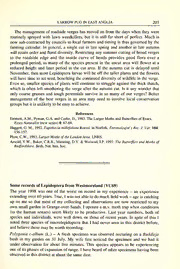
Some records of Lepidoptera from Westmoreland (VC69) PDF
Preview Some records of Lepidoptera from Westmoreland (VC69)
YARROWPUGINEASTANGLIA 203 The managementofroadside verges has moved on from the days when they were routinely sprayed with lawn weedkillers, but it is still far short ofperfect. Much is now sub-contracted by councils to local farmers and timing is thus governed by the farming calendar. In general, a single cut in late spring and another in late autumn willretain orderand floral diversity. Restricting any summercutting ofbroad verges to the roadside edge and the inside curve of bends provides good flora over a prolonged period, as many of the species present in the uncut area will flower at a reduced height and later period in the cut area. If the autumn cut is delayed until November, then most Lepidoptera larvae will be offthe tallerplants and the flowers will have time to set seed, benefiting the continueddiversity ofwildlife in the verge. Even so, smaller species ofplants will continue to struggle against the thick thatch, which is often left smothering the verge after the autumn cut. Is it any wonder that only coarse grasses and tough perennials survive in so many of our verges? Better management of the best verges in an area may need to involve local conservation groupsbutitisunlikelytobeeasy toachieve. References Emmett,A.M.,Pyman,G.A.andCorke,D., 1983.TheLargerMothsandButterfliesofEssex. EssexNaturalist(newseries)8:67-68. Haggett,G.M., 1992.EupitheciamillefoliataRoessl.inNorfolk.Entomologist'sRec.J. Var. 104: 156-157. Plant,C.W., 1993.LargerMothsoftheLondonArea.LNHS. Arnold,V.W.,Baker,C.R.B.,Manning,D.V. & Woiwod, LP. 1997. TheButterfliesandMothsof Bedfordshire.Beds.Nat.hist.Soc. SomerecordsofLepidopterafrom Westmoreland (VC69) The year 1998 was one of the worst on record in my experience - an experience extendingover60years. True, I was notabletodomuch fieldwork-age is catching up on me so that most of my collecting and observations are now restricted to my own small garden in Grange-over-Sands. I operate am.v. moth trap when conditions (to the human senses) seem likely to be productive. Last year numbers, both of species and individuals, were well down on those of recent years. In spite of this I noted three species ofmacrolepidoptera that I had never seen in this district before, andbelievethesemaybeworthrecording. Polygonia c-album (L.) - A fresh specimen was observed nectaring on a Buddleja bush in my garden on 31 July. My wife first noticed the specimen and we had it under observation for about five minutes. This species appears to be experiencing oneofitsphases ofexpansionofrange. I have heardofotherspecimens having been observedinthisdistrictataboutthe samedate. 1 204 ENTOMOLOGIST'SRECORD,VOL. 11 25.ix.1999 Eublemma parva (Hb.) - A fine, fresh, male specimen was taken in my trap on 4 July. It is a specimen with very pale facies and faint markings and would be var. pallida Tutt (vide Tutt, J.W. TheBritishNoctuae andtheir Varieties Vol. IV: p.ll). There are very few records of this species for northern England. Being a small species, it could be readily overlooked - and to the collector ofmacroplepidoptera could well be mistaken for a "micro". So, its apparent scarcity may well be only apparent. Lithophane leautieri ssp. hesperica Boursin. A specimen of this was taken in my trap on 2 October. It was one of only two moths in the trap (the other was Aporophyla nigra (Haw.)). So far as I know, this is only the second record for leautieri in VC69; I understand one was taken in Kendal in October 1996 (W.D. Kyddpers. comm.). Whilemoth numbers in the trap were fewerthan usual, social wasps (Vespula sp.) were far too numerous, so that sorting the catch was often a hazardous procedure.- NevilleL. Birkett, Beardwood,CarterRoad,Grange-over-SandsLAI1 7AG. Plant-bugs (Hemiptera) on Woolwich Common,south-eastLondon I was much surprised to sweep an example of the Bishop's Mitre shield-bug Aelia acuminata (L.) (Pentatomidae), from low mixed herbage at the edge of a strip of semi-woodland in the above locality on 19 September 1998. Officially, this grass- feeding species is no rarity; it may be, or may have been, common enough in some otherparts ofthe country, but this is only the second specimen I have met with, and the firstwasnothere. Anotherpentatomid, the strikingEurydema oleracea (L.) -already recordedfrom here in this journal (Allen, 1992: 79-80; 1994: 30) - may be mentioned here on account ofthe plant on which it occurred. The usual host on Woolwich Common is horseradishArmoracia, but on 19 May 1999 one was brushed offhoary pepperwort Cardariadraba, whichgrew inthickmassesatthe spot. Ihavenodoubtthatthisis a foodplant; therewas noArmoracianearbyandinfactithadscarcelybeguntoappear aboveground. On the same day an example ofRhopalus subrufus (Gmel.) (Rhopalidae) was swept from a variety of low plants. Its most usual host, Hypericum, was nowhere near. This too is regarded as a common bug, but certainly cannot be so now in the London area, where I had never before seen it. Close by, the coreid Coriomeris denticulatus (Scop.) was on its chieffoodplantMedicago lupulina, as ratheroften in previous years. Also in evidence was the curious small hopper Asiraca clavicornis (F.) (Delphacidae). This grass-feeder used to be considered a very local rarity, but has proved to be far from uncommon in my district.- A.A. Allen, 49 Montcalm Road, Charlton, London SE7 8QG.
